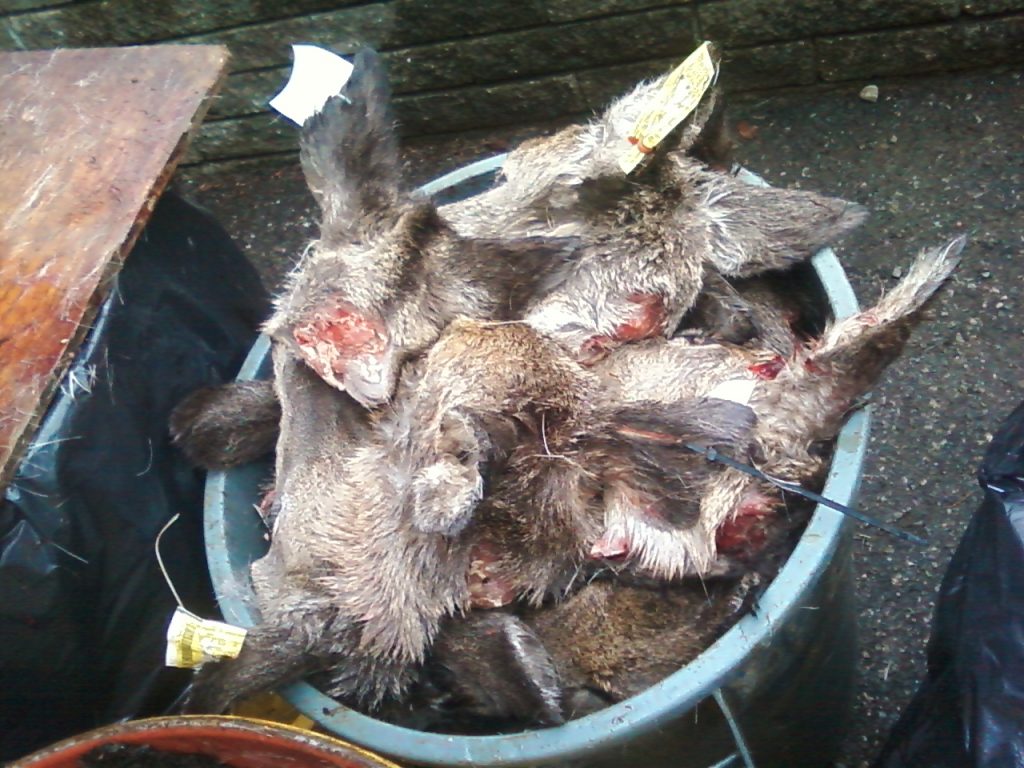Halloween is right around the corner so what better time for a horror story. It is a tale of fear and loathing; of panic and dread; but mostly pain…on my part anyway. In fact, all those adjective are describing my attempt at comprehending recently published research on CWD.
Remember that CWD paper that we talked about a couple of weeks ago. Well another CWD paper, Chronic wasting disease in white-tailed deer: infection, mortality, and implications for heterogeneous transmission, was just published using data from Wisconsin and Illinois.
It isn’t getting nearly as much play as the previous paper. Probably because the title is not quite as attention grabbing as Chronic wasting disease drives population decline of white-tailed deer and because it is so complex that those outside the profession (and even inside the profession) have difficulty understanding it.
While CWD causes holes in the brain, after reading this paper I was afraid mine might explode. To see if this was a real possibility, I turned to Google, the knower of all things. You can imagine my shock when Exploding Head Syndrome appeared as the first 3 results. CRAP! I closed the PDF of the paper and immediately started yogic breathing.
As it turns out, Exploding Head Syndrome is a benign condition. Well, that’s a relief. But it really didn’t help me with regard to understanding this publication.
The purpose of this study was to investigate the rate of CWD infection and disease-associated mortality for white-tailed deer harvested from two outbreak areas in south-central Wisconsin and northern Illinois–eastern Wisconsin while considering the effects of age misclassification on epidemiological parameters estimated from age-prevalence data.
Ok, I get that. They wanted to look at CWD infection and mortality as it relates to actual age of deer. Deer are typically aged by one of 2 methods: tooth replacement and wear patterns or counting cementum annuli on incisor roots. Age estimates are more accurately determined using cementum annuli.
Does the age of a deer really matter? Sure, chronic diseases like CWD and bovine TB could be more likely to occur in certain ages. This could impact management. For example, managers may want to focus on the age classes with the highest incidence of the disease.
Thousands of harvested deer were aged by tooth replacement and wear and a subsample of teeth were sent away to be aged via cementum annuli. That allowed them to correct for any aging errors. After the ages were corrected, prevalence (prevalence is a measurement of all individuals affected by the disease at a particular time) estimates showed a more consistent age pattern than prevalence based on tooth replacement and wear, especially for older age classes.
In other studies and when researchers used the uncorrected age data, it appeared there was a decline in prevalence for older males and females. So there is truth that age misclassification can give misleading impression of prevalence among age specific classes. Good to know.
I was holding on until this point but then the wheels started to fall off. Here is a excerpt from the results section:
[Disease] Transmission coefficients (β) represent the potential rate at which infectious individuals make contact with susceptible individuals and successfully transmit disease. β for adult males was more than fourfold higher than adult females and 10-fold higher than yearlings (Table 3). When hypothesized transmission excludes infectious contact between yearlings and adult males and includes symmetric infection between males and females (WB1), βM,M is approximately 5 and 30-fold higher than for female-to-male (βF,M) transmission and transmission among females and yearlings (βF,F and βF,Y), respectively. When asymmetric transmission from females to males (βF,M) is twice (WB2) the inverse rate (βM,F), the male-to-male(βM,M) transmission is 2–25-fold higher than transmission among other classes. Only when asymmetric transmission from females to males is threefold higher than the inverse (WB3) does the impact of CWD transmission from females to males become similar to the transmission among males. Under this latter model, transmission between adult males and between adult males and females is estimated at >10-fold higher than transmission among female and yearling deer.
And that’s one of the more understandable passages. I’d love to translate that into English for you but I just can’t. This is also the point at which I began to doubt that Exploding Head Syndrome was benign.
Let’s skip to some conclusions made in this study:
- The more complex models were selected for the age-corrected prevalence data
- There was greater than threefold higher infection rates in adult males compared to adult females, and much lower infection in yearlings
- CWD has a significant impact on the annual survival of adult male and female white-tailed deer in these two outbreaks
- As CWD prevalence increases, the magnitude of population impact will also increase—eventually resulting in a decline in deer abundance.
This paper was HEAVY on the modeling. And by the authors own admission, the more complex models are the ones that fit the best. Models are wonderful for helping us understand what could happen but the more complex they get, the more assumptions are made, and the farther from reality they can be.
One of the primary conclusions was that adult males had a higher infection rate than adult females. Other research has noted the same thing. But recall again the Wyoming study. Bucks are more common in the harvest and CWD-positive bucks were harvested at a higher rate than expected. CWD prevalence in the population (as opposed to CWD prevalence in the harvest) was actually higher for does than bucks.
This study used 9 years of harvest data. If CWD-positive bucks are more likely to be harvested, than it is no wonder they appear to have higher infection rates. But do they really? It is important to consider the source of the samples as it has been demonstrated that different sampling methods yield different results.
What my as-yet-unexploded-head can get behind is this: “As CWD prevalence increases, the magnitude of population impact will also increase.” That white horse is still out there.
Biologist
If you would like to receive email alerts of new blog posts, subscribe here.
And Follow us on Twitter @WTDresearch

